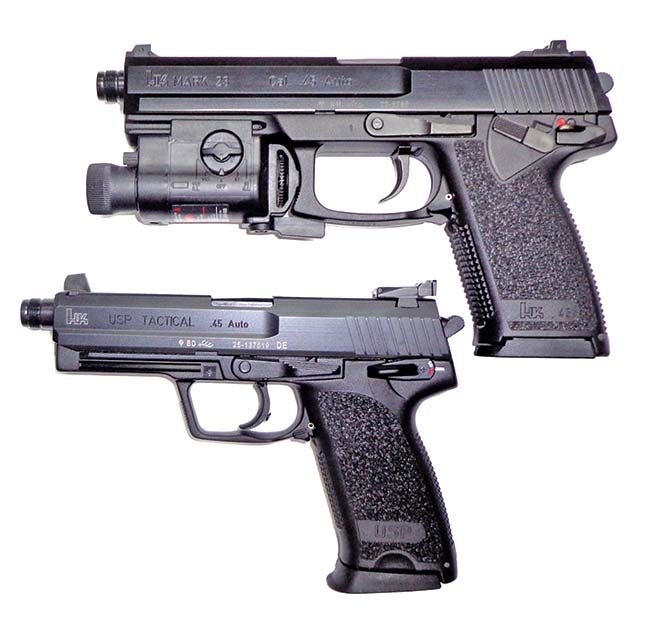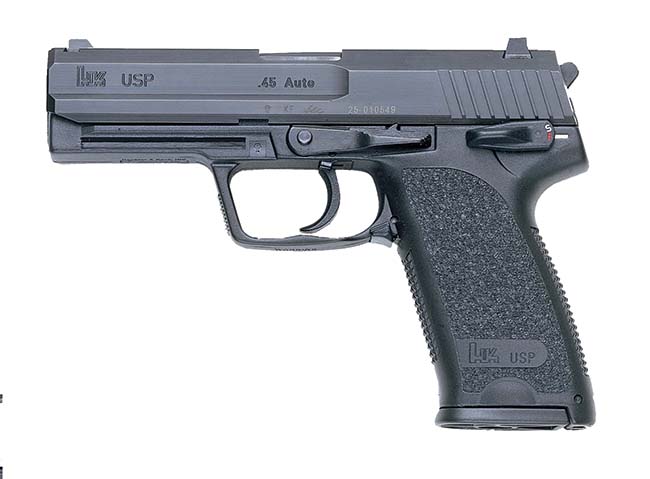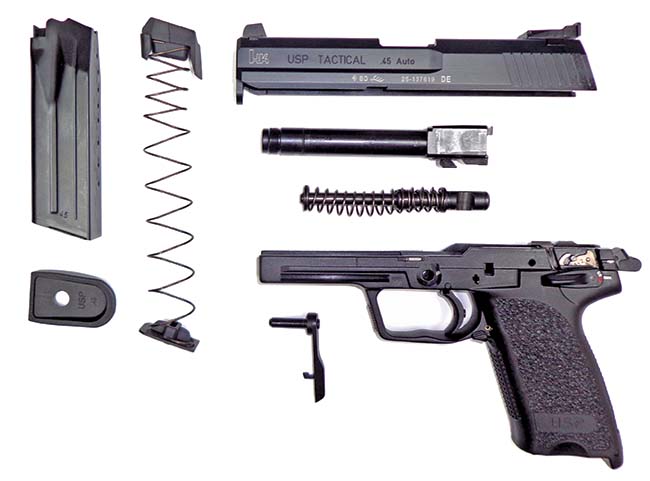ABOVE: Police Officer and SWAT Sniper Fabian Rivera firing the H&K USP Tactical. Notice the pistol is in full recoil. His SWAT team carried USP45 pistols up until the last few years when the department switched over to a new pistol and everyone in the department had to have the same pistol.
Traditionally, Heckler & Koch has been known for making some of the finest pistols and assault rifles in the industry. They have also had a major handicap that has prevented them from being as prevalent in the law enforcement and military market: the extremely higher than normal price. H&K has priced themselves out of much of the commercial and military market in the U.S. In 1989, H&K completed a study of the United States pistol market and came up with a set of criteria they would need to meet to compete with Glock, Beretta, SIG Sauer and Smith & Wesson. In September of 1989 work began on this new generation pistol. The criteria needed for this new pistol was to be affordably priced, conventional design, innovative features, reliable, durable, safe, accurate, high quality, advanced materials, large magazine capacity, low recoil, user friendly, many modes of operation and conventional locking system.
During these early days of research and development, another pistol opportunity presented itself. In February of 1991, United States Special Operations Command announced their Offensive Handgun Weapon System (OHWS) proposal. Much of the criteria for both pistols were the same and both pistols would use the same basic technology. The OHWS would be put through the toughest testing the world has ever seen for a pistol. In September 1991 the acronym USP or Universal Self-loading Pistol was assigned to the new family of weapons. The pistol was designed for the newly introduced .40 S&W caliber pistol. Unlike most of the other pistols in the industry, the USP was designed for this new caliber, not a 9mm pistol modified for the larger caliber. Prototype 1 was reviewed in February 1992 and the second prototype in June of 1992. In August of 1992, H&K delivered 30 OHWS pistols to SOCOM, which would eventually be adopted as the MK23 MOD O pistol. In September of 1992, the third prototype was reviewed and endurance testing began. In December, both the USP40 and USP9 completed the first half of the 20,000 round endurance testing. Upon completion, the USP design was frozen and production planning began. The USP was unveiled at SHOT Show in 1993 and in February 1993 USP production began at H&K GmbH in Germany. That same month the USP40 Variant 7 was submitted to U.S. INS/Border Patrol for evaluation. In April of 1993 the first USP40s arrived for sale at H&K Inc. for purchase, followed in June by the USP9.

The early pistols (USP40 and USP9) both operated from short recoil modified Browning-type linkless system. Sights provided were fixed partridge style, adjustable for windage and elevation. Standard white 3 dot and tritium sights were also available. The total length of the pistol is 7.64 inches with a barrel length of 4.13 inches. The barrel twist length for the USP40 is 14.96 inches and the USP9 9.84 inches. The width of the slide is 1.14 inches with the frame being 1.26 inches. The total weight of the USP40 with an empty magazine is 29.62 ounces and the USP9 is 28.46 ounces. The slide force on both pistols is 17.64 pounds.
One of the very unique features of the new USP pistol was that the fire control was offered in 10 different variants. Any pistol can be converted by an armorer to any of the variants offered. Both right and left hand controls were made available to the customer in an easy to reach location. They allowed for various modes of carry that include decocked safety on, decocked safety off, hammer cocked with safety on, double action only safety on as well as double action only no safety like that of a revolver.
- Variant 1: Single Action / Double Action with manual “Safe” position and safety/decocking lever (left side).
- Variant 2: Single Action / Double Action with manual “Safe” position and safety/decocking lever (right side).
- Variant 3: Single Action / Double Action without manual “safe” position with decocking lever (left side).
- Variant 4: Single Action / Double Action without manual “safe” position with decocking lever (right side).
- Variant 5: Double Action Only with manual “safe” position with safety lever (left side).
- Variant 6: Double Action Only with manual “safe” position with safety lever (right side).
- Variant 7: Double Action Only without manual “safe” position or safety/decocking lever.
- Variant 8: Double Action Only model that was especially configured for a U.S. government agency test in the 1990s. Never produced.
- Variant 9: Double Action / Single Action position and control lever with manual safety and no decocking function (left side). Cocked and locked version.
- Variant 10: Double Action / Single Action position and control lever with manual safety and no decocking function (right side). Cocked and locked version.
The pistol was designed to be a combat pistol, but as a safe to carry combat pistol. The basic variants (1, 2, 5, 9 and 10) have a manual safety. All have a double action mode of carry. All models have a passive disconnector safety that ensures that the slide must be in battery for the USP to fire. If the USP slide is out of battery, then the solid portion of the slide pushes the disconnector and therefore the trigger bar out of engagement with the catch and the hammer. The drop safety on the sear actuator latch blocks the hammer from striking the firing pin unless the trigger is pulled so when the hammer is in the decocked position, it is not in contact with the firing pin (like a 1/4 cock if you will) and the most important the firing pin block. The firing pin safety blocks the firing pin’s forward movement under spring pressure. When the trigger is pulled all the way to the rear, the tip of the catch is activated by the forward movement of the trigger bar and lifts the firing pin block out of position so when the hammer strikes the firing pin, the firing pin will be able to protrude enough from the breech face to ignite the primer. Early service pistols such as the Colt M1911 and the Browning High Power lacked this device and were prone to unintentional discharge by dropping the pistol on its muzzle from less than 5 feet.
The pistol uses the modified Browning-style locking system (linkless) that is a time proven mechanism that is combat demonstrated as well as allows for a simple, reliable, easy to replace barrel and is inexpensive to produce. Early USP barrels did not use H&K trademark hammer forged polygon rifled barrels. They opted for conventional 6 lands and grooves with right hand twist barrels. However, customers began to complain about the fact the barrels were not the hammer forged polygonal technology and H&K heard and listened to the customers. Within 2 years of production H&K went to their hammer forged barrels.
The slide release is extended rearward to make for easier actuation and also doubles for takedown of the pistol. The magazine release is also ambidextrous; it is activated from either side without the need for being swapped to the other side like most pistols of the time.

The slide of the USP pistol is manufactured by milling a single piece of 42 Cr Mo 4 steel. Machining is flawless, which is what you expect from H&K. The finish of the slide is called HE or Hostile Environment. The slide finish is extremely hard (732 HV1 Vickers), is corrosion resistant and is a proprietary nitrogen/carbon process. All other internal and external components are finished with a unique Dow-Corning “Molykote” finish that was tested and proven by the German Navy Kampfschwimmer (Combat Swimmers). All parts are finished in this making them resistant to corrosion and wear due to the non-reflective finish. The extractor is aggressive and pivots on its center axis. When looking at a USP40 and a USP9 slide from the bottom you can easily see where much material has been removed for use with the lower power 9mm cartridge
One of the most interesting aspects of the USP is its use of a proprietary glass fiber reinforced polymer material the frame is made out of. Molded into the frame are metal guide rails as well as the serial number plate. H&K is not new to polymer frames. They, in fact, predate Glock with the VP70, G11 and CAWS. This strong polymer is actually in many ways stronger than steel. The polymer absorbs recoil rather than have impact of metal on metal, which will wear on the metal. There are tear-away grooves allowing the shooter to grasp the magazine and remove it if it should become stuck. The trigger guard is very oversized permitting those with winter gloves the ability to manipulate the trigger. Like any good service pistol, the pistol incorporates a lanyard lock. The texture is stippled and grooved with the stippling on the front and backstrap quite aggressive – in fact some may say too aggressive. People have been known to take a file to them to dull them down a bit. Certainly they are anti-slip.
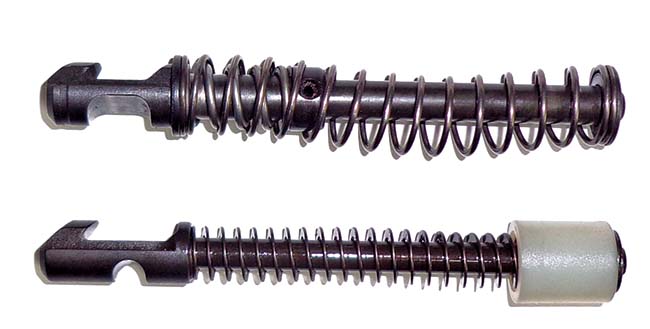
The magazines for the pistol are manufactured from the same material as the frame of the pistol. They contain a stainless steel insert to insure uniformity and that the magazines will drop free from the magazine well. The USP40 magazine contains 13 rounds and the USP9 contains 15 rounds. On the rear of the magazine are witness holes so the shooter can see exactly how many rounds are in the magazine by simply looking at the back of the magazine.
Perhaps the crowning achievement H&K accomplished with this pistol is the U.S. Patent Number 5,309,815 (May 10, 1994) mechanical recoil reduction system that was first used in the development of the OHWS/MK23 pistol. This devise reduces the recoil force by up to 30%. This adds many features to the pistol. First and foremost it reduces stress on the components of the pistol. This results in longer service life even when using +P or +P+ ammunition. One of the requirements for the OHWS/MK23 was its compatibility with +P ammunition, which would eventually destroy an M1911-type pistol. In turn, the mechanism reduces felt recoil to the shooter. This also makes for a pistol that has decreased sensitivity to ammunition variations. This mechanism makes the USP one of the few pistols on the market at the time that could handle the high pressures associated with the .40 caliber round as well as have a 9mm pistol that could handle without issue a steady diet of +P and +P+ submachine gun ammunition without damage to the pistol. The life of the frame of the OHWS/MK23 surpassed any pistol on the planet. The USP shares this as well.
The USP was one of the first pistols to have a Universal Mounting Groove (UMG) on the front of the frame. This was pre-Mil-Std 1913 rail. This UMG allowed easy installation of lasers, flashlights and optical sights. The groove made the accessory parallel with the bore and was exceedingly more secure than mounting to the trigger guard.
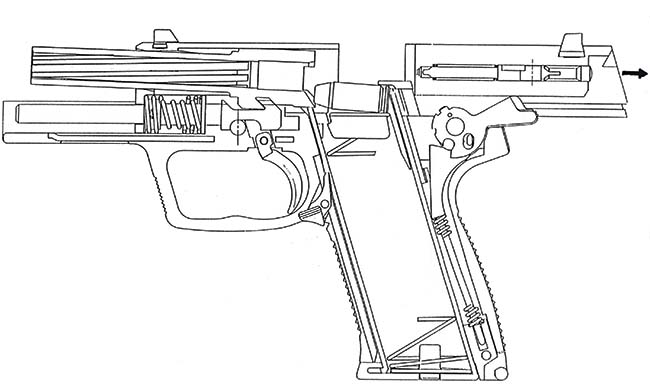
Testing of the USP40 was significant. The pistol was tested and passed the military (NATO) testing procedures. These far exceed the testing standards the industry does for commercial products. The NATO test included tolerance inspection on trigger pull, firing pin energy/protrusion, headspace, velocities, etc. The controls and safeties were tested as well as testing with two Winchester DP40 proof loads. Targeting testing included zeroing at 25 meters (point of aim/point of impact) and ammunition compatibility (as of this time more than 85,000 rounds had been fired thought the USP40). The accuracy testing showed the most accurate being 3.2 to 3.9 inches with Winchester 155 grain Silver Tip Hollow Point and Remington 155 grain Jacketed Hollow Point. Reliability testing consisted of 20,000 rounds fired in various attitudes. Parts were checked for damage every 1,000 rounds. The slide was cycled manually 1,000 times after firing every 10,000 rounds. Test results showed no normal wear detected in less than 5,100 rounds. The pistols performed flawlessly in the testing. Also conducted was a barrel obstruction test where a live round was fired with a projectile positioned at the forcing cone and another test with the projectile inserted 1.18 inches into the muzzle. There was no damage to the pistol and accuracy was unaffected. The pistol was submitted for drop testing and the pistol was dropped on all six sides plus 45 degree top of muzzle onto rubber from a height of 4 feet as well as six times onto cocked hammer on steel and concrete from a height of 3 to 6.7 feet with no ignition of the primed cartridge case nor any indent on the primer. Fouling testing consisted of the pistol firing 1,000 rounds without cleaning or lubrication. No malfunctions had occurred. The last portion of the test was environmental, which consisted of low temperature (-51 F), high temperature (145 F), thermal shock (-50.8 to +145.4 F), mud bath (10 minutes exposed), sand (10 minutes) and freezing rain (1 hour to -50.8, sprayed with water to .039 to .118 inches thickness). The USP40 passed all testing.

The USP was an instant hit in the United States with both commercial and LE customers. The MK23 Mod 0 was less successful with SOCOM due to no fault of the pistol. It was truly the most advanced pistol in the world. But the size was the problem. It was too large for the operators to carry. They got accustomed to the low recoil 9mm caliber pistols with 15 round magazine capacity such as their SIG Sauer P226 pistols. So unfortunately this pistol never saw the use for which it was designed. But the pistol was a success in that it did exactly what SOCOM wanted. There was a gap now in the USP line up. Although it was built for the American market, it was not in America’s caliber, 45 Auto. Soon after the release of the USP40 and USP9 the market asked for a USP pistol chambered in the classic American caliber. At SHOT Show 1995, the American prayers were answered. The USP45 was basically a USP40 on steroids. The USP45 clearly showed its lineage with the MK23 minus the threaded barrel and without the rubber O-ring. The USP45 retained the USP fire controls as opposed to the MK23 with its separate decocking lever and safety. The USP45 was of course slightly larger. The barrel length is 4.41 inches long and the pistol 1.90 pounds compared to the USP40 weighing 1.74 pounds. The height of the USP45 is 5.55 inches compared to the 5.35 inches of the USP9/USP40. The overall length is 7.87 inches compared to the 7.64 inches in length of the USP9/USP40. At the time of its introduction, the U.S. Crime Bill was in effect limiting magazine capacity to 10 rounds. The non restricted magazines held 12 rounds of .45 Auto caliber ammunition. The pistol had the polygonal rifling from the beginning. The pistol was also an instant success. This pistol got attention from law enforcement as well not only as a duty weapon but also as a SWAT weapon. It was adopted by the City of Rochester New York Police Department Emergency Task Force as their sidearm. The recoil was less than any other pistol of its caliber. The true nemesis of the USP45 is the Glock 21. Special Operation groups liked the USP45 as well. Although similar in design to the MK23, the USP45 was much smaller making it an excellent sidearm in .45 Auto caliber. The MK23 was designed to be an offensive weapon, part of a three piece system including the pistol, a laser aiming module and a sound suppressor. The USP45 was comparable in size to that of the SIG Sauer P226 they had carried. The USP45 and soon to be introduced other variants would not become truly realized until the onset of the Global War on Terrorism after the September 11, 2001 attack. For the first time since the Vietnam War, American soldiers would be involved in infantry and special operation engagements on a foreign land. The troops and operators found out really quick the benefit of a .45 caliber handgun over the 9mm pistol they were so fond of in peace time training.
The T&E pistol, as requested, was the traditional and most common version of the USP 45 pistol: the Variant 1, which has a safety, decocker as well as permits carrying in the cocked and locked position. This pistol has gone through incremental improvements since its introduction. The sights on this pistol are the common 3-dot system with white dots. The pistol performed flawlessly and was very accurate with offhand groups at 15 yards under 2 inches.
The USP45 spanned a wide array of uses – the commercial market, self defense, competitive shooting, law enforcement as well as military. The pistol could be modified to fit each of those applications that much better.
The USP45 Compact
In 1997, H&K introduced their next version of the pistol, the USP45 Compact. This pistol was only 5% larger than the 9mm version with a 3.78 inch barrel and an overall length of 7.09 inches. The magazine held 8 rounds. To make for a more snag free design, the hammer of the pistol was bobbed. This pistol too had the proprietary mounting groove. The USP compact only employs a polymer absorber bushing due to the length restrictions on the compact guide rod. The bushing does not reduce recoil; it simply stops the slide from directly engaging the frame after firing. The weight of the pistol is only 1.76 pounds.
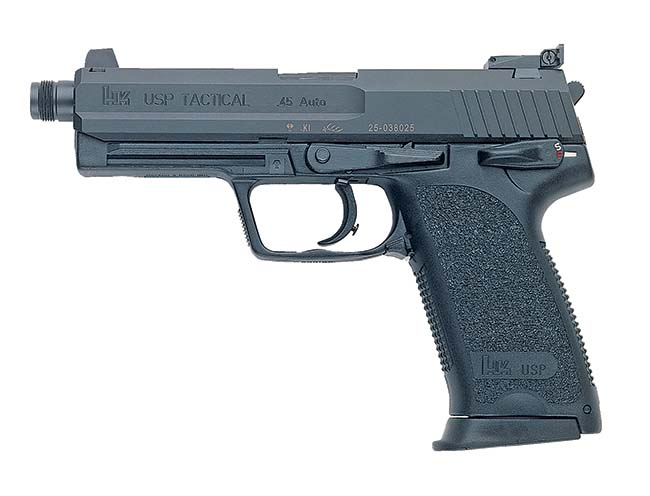
The USP45 Tactical
The MK23 Mod 0 was without a doubt the most advanced pistol in the world but as previously stated very large. The pistol was nicknamed the “crew served pistol” by those who used it. The demand came from the customers for a USP45 pistol with all of the advanced features of the MK23. In 1998 that pistol was introduced: the USP45 Tactical. The 5.09 inch barrel incorporated the O-ring of the MK23 to increase accuracy as well as the muzzle of the barrel was threaded to accept a sound suppressor. The weight of the USP45 Tactical is 2.05 pounds compared to the 2.46 pounds of the MK23. The overall length of the USP45 Tactical is 8.64 inches compared to 9.65 inches of the MK23. The sights are high profile for use with the sound suppressor. The rear sight is fully adjustable for windage and elevation as well. The trigger is improved with a match single and double action. The trigger has an adjustable trigger stop to eliminate trigger over-travel. Like the MK23, the pistol has the patented recoil reduction system. The extractor doubles as a loaded cartridge indicator. The same 12-round magazine is used in this pistol as the standard USP 45.
The T&E pistol is quite impressive and it is easily seen why one may prefer this over the MK23. It is smaller and does everything the giant crew served handgun will do. This pistol proved to be the most popular with the police/SWAT officers that tested the firearms with this author. The sights proved to be extremely accurate and the groups tightened up a little off hand. On a bench the groups tightened up to an in to an inch and a half with Hornady Critical Duty 220 grain +P ammunition.
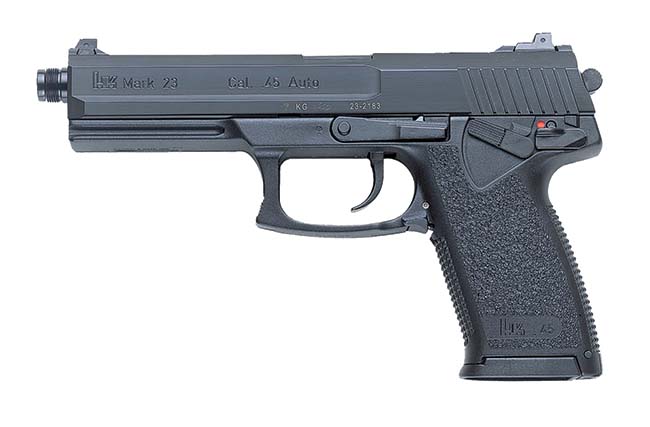
The Mark 23
Like most military weapons, the commercial market wants the same high-tech weapons as the military. Once the story broke of the history and developments of the MK23 Mod 0 pistol there was an immediate commercial demand. H&K responded with the Mark 23 in 1998. There are only two real differences between the two pistols. The Mark 23 has the SAAMI spec .45 Auto chamber and the marking on the slide differentiates the military model from the commercial version. This pistol always carried a hefty price of nearly US$1,800 but they have always sold as many as they could produce.
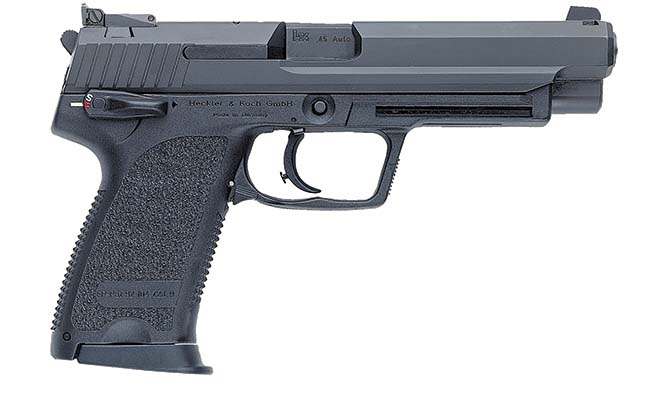
The USP45 Match
The 3-gun shooters as well as combat pistol shooters requested a model of the USP45 that was more geared for competition. In 1998, H&K introduced the USP45 Match. This pistol is the basic USP45 with some very significant changes. The rear sight is a target sight with a micrometer for adjustments in windage and elevation. The barrel length is extended to 6.02 inches. There is a custom barrel weight assembly added to perfectly balance the weight of the pistol. The pistol has a 10 and 12 shot magazine. The weight of this pistol is 2.38 pounds with an overall length of 9.45 inches. The trigger has an adjustable trigger stop for precise let off.
The USP Expert
Introduced in 1999, the USP45 Expert has many modifications from any previous pistol. The control lever is on both sides of the frame making it fully ambidextrous. The slide has been elongated to assist in balance and to cover the longer 5.20 inch barrel. The trigger is match grade in both single and double action along with an adjustable trigger to eliminate over-travel. The barrel has the O-ring for increased match accuracy and the extractor also works as a loaded chamber indicator. Like all before it, this pistol too has the recoil reduction mechanism. The pistol weighs in at 2.30 pounds with an overall length of 8.74 inches. Both 10- and 12-round magazines are offered.
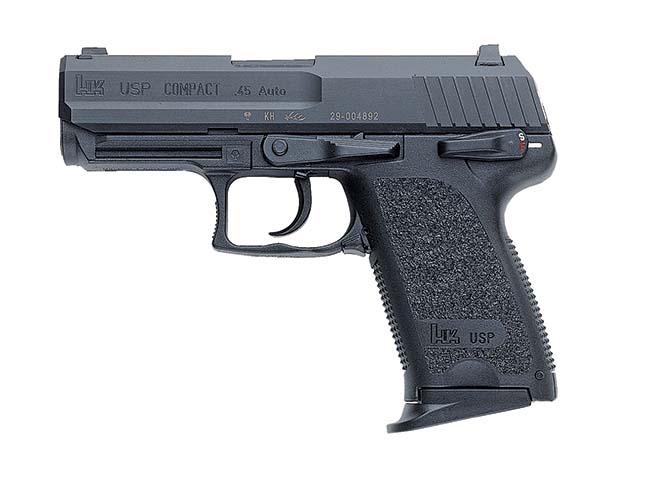
The USP45 Compact Tactical
This pistol is the basic USP45 Compact pistol with a threaded barrel to accept the sound suppressor. The magazine holds 8 rounds. The hammer is bobbed so not to snag on clothing. The barrel length is 3.78 inches with an overall length of 7.09 inches
The USP45 Elite
This too is a modified pistol for the combat shooter or special operation operator. The slide has been extended to cover the 6.02 inch barrel to both extend the range of the pistol and to balance the pistol. The barrel has the O ring to increase accuracy as well. The trigger is also a match trigger with an adjustable trigger stop. The pistol can be had with both a 10- and a 12-round magazine. Target sights are standard with the rear sight having a micrometer for adjusting both windage and elevation. The pistol has an overall length of 9.45 inches which is comparable to that of the MK23. This pistol also features a chamber loaded indicator.
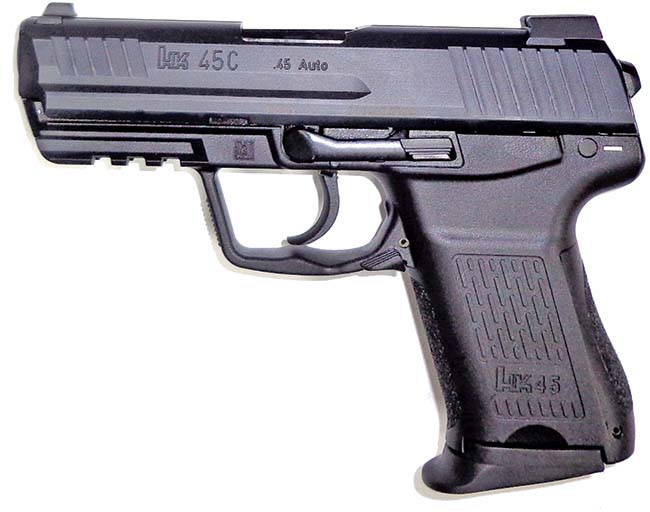
The HK45
The HK45 is the newest member of the H&K 45Auto family of weapons. It is actually quite different than the USP. This also marks the first American made USP pistol manufactured in the New Hampshire plant. The overall size is actually smaller than that of the original USP40/USP9. The grip is similar to that of the P30 series with modular backstraps to accommodate the size of the individual shooter’s hand. The frame is also equipped with a Mil-Std 1913 accessory rail. The slide is contoured and radiused with a forward slide gripping groove. The safety lever is an improved slimmer contour. The slide catch lever is on both sides making the pistol fully ambidextrous. The barrel is 4.47 inches with traditional polygonal rifling. The barrel is equipped with the accuracy enhancing O ring. The weight of the pistol is 1.95 pounds with an overall length of 8.03 inches. The magazine is not the standard USP 45 one but modified to accommodate the thinner grip. This magazine has a capacity of 10 rounds. The T&E pistol was also equipped with TRU DOT tritium night sights. The sights are standard so they would not be able to be used if the pistol was to be equipped with a sound suppressor. This pistol does not share the recoil reduction mechanism of the USP full size and MK23/MARK23 pistol but the one used in the compact type pistols. The extractor doubles as a live cartridge indicator.
The T&E pistol shot flawlessly. This is the new series HK45 version of the USP Tactical. The grip was noticeably smaller. Those with smaller hands commented on their preference for it. There was really no noticeable recoil difference given the different recoil reduction system. The USP Tactical has the edge on accuracy but that could be attributed to the USP Tactical having target sights instead of combat sights (three dot).
The HK45 Compact
This is the compact version of the HK45. The barrel is 3.90 inches long with an overall length of 7.27 inches. This small package packs 8 rounds of .45 Auto ammunition and keeps all of the advanced features of the HK45 but in a smaller package. The barrel also has the rubber O-ring for increased accuracy. To assist in concealment the hammer is bobbed to avoid snagging on clothing. This pistol comes standard with TRU DOT tritium night sights. The slide is low profile and slim lined for ease of concealment. The entire pistol weighs 1.78 pounds with an empty magazine. The T&E pistol is equipped with the LEM trigger system. The extractor also doubles as a loaded chamber indicator. This, like its bigger brother, has a Mil-Std 1913 rail on the front of the frame.
This T&E pistol is perhaps the most impressive of the lot; mostly due to it being compact with the recoil of the full size. There was little noticeable recoil in the smaller gun. This author has very large hands and was able to grip the pistol firmly. The LEM trigger proved to be very nice and very accurate.
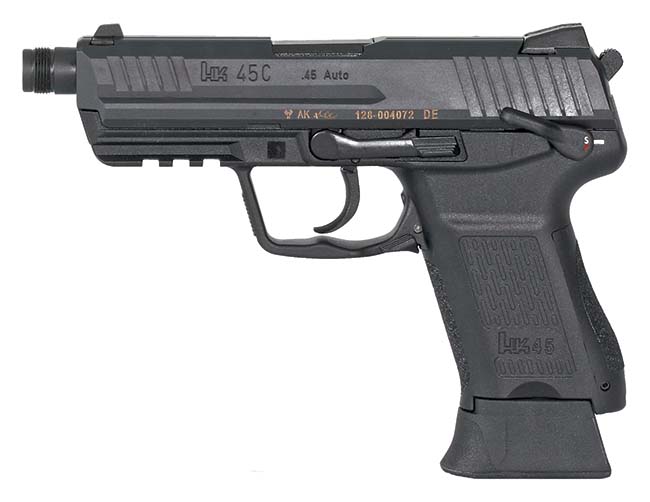
The HK45 Compact Tactical
This pistol is identical to the HK45 Compact with a couple additions. The first is a 4.57 inch threaded barrel to accept a sound suppressor. It also comes with a 10-round magazine and a extended floorplate and grip backstrap. The increase in weight is negligible at 1.82 pounds, only 4 ounces different.
Although the USP is 20 years old, it is still state-of-the-art. H&K continues to build on it modernizing it for the changing times. The USP series pistol is in service throughout the world, although not necessarily in .45 Auto caliber. There is no doubt that the .45 Auto is America’s caliber and will be with us for a very long time. Deep rooted in tradition as well as a well backed up reputation make it one of the finest combat pistol calibers of all time. H&K has undoubtedly been on the forefront of modernizing pistols to fire this over 100 year old cartridge with the MK23, making the most advanced handgun in the world using this proven cartridge. The American market will continue to procure pistols from H&K in this caliber and by Americans I mean commercial, law enforcement as well as military. These pistols have seen service with American forces in the Global War on Terrorism as well as many other places throughout the globe including the MK23, USP45 and the USP45 Tactical models. The adaptability to any trigger variation has also put this gun on the list for law enforcement. Although not the most popular caliber abroad, the pistols in their 9mm variations are in use by the security forces of Australia, Denmark, Estonia, France, Germany, Greece, Ireland, Japan, Lithuania, Luxembourg, Malaysia, Poland, Portugal, Singapore, South Africa and Spain. Also in that lineup are numerous U.S. military and law enforcement agencies. These are top tier pistols used by top tier operators.
